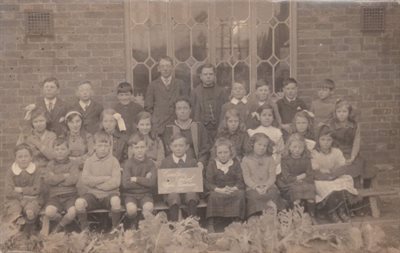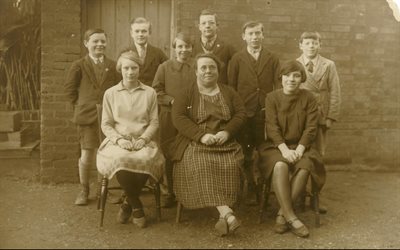Carlton School 1919 to 1945
This page was contributed by Pamela Hider
School Logbooks 1919-1944
The information below is taken from the logbooks for Carlton School for 1919-1944. Logbooks from the 19th and 20th centuries give us a fascinating account of life at schools from the beginning of our national education system and of how education evolved throughout its first hundred years, particularly in a rural setting such as Carlton. They also reflect the many changes in society that took place during that time such as hardship, disease and world wars, through to population growth, the affluent society, a National Health Service, technology and vast opportunities. Access to the logbooks was provided courtesy of the Headteacher of Carlton Primary School.
During the next 18 months, there were to be three temporary Head Teachers: George W. Shimmin, Amy F. Berry and Flora Shelford. Drawing was to be introduced to girls; a concert was held at which 'a few parents were present' and a little new stock was delivered.

Carlton School Dec 1919 with Mr.G. Shimmin, temporary Head and Miss Holloway Assistant Mistress (courtesy of Carlton & Chellington Historical Society)

Carlton School January 1921 with temporary Head, Miss F. Shelford (courtesy of Carlton & Chellington Historical Society)
At last, a new permanent Head Teacher was found and in April 1921, Leah B. Abbott took charge of the school, where she was to remain for more than 23 years. Mrs. Abbott (b.1883) and her husband Ernest (of Abbott's Dairies) came from Rushen, Northamptonshire where she had been a certified Assistant Mistress.

Carlton School mid 1920s with Mrs. Abbott and pupils (courtesy of Carlton & Chellington Historical Society)
Logbook entries now became briefer and more pragmatic, totalling half the number of pages written by her predecessors. New entries consisted of: regular medical visits by a doctor, nurse and dentist (including immunisation against diphtheria in 1941 & 1942); the brightest children being awarded free places at Bedford Modern school; nature rambles & survey expeditions in the surrounding lanes (a new prize was inaugurated for the best wild flower collection and was recorded as being awarded in 1925, 1926 & 1938); and the school was also used for Government Elections. Christmas Parties were recorded in 1937, 1938 & 1940.
Up until 1933, the number of pupils on the books ranged from 45 to 53, falling to 28 to 39 by 1941. Numbers then rose with the influx of 26 evacuees from Eastbourne, who came with their own teacher, Mr.Kent, but fell again to 34 with the 'falling off of evacuee numbers'. Attendance over the years 1921to1944 ranged from 11 to 46, the lowest numbers being caused by very severe weather, smoke-filled classrooms and childhood illnesses and epidemics. The lighting of fires was also recorded (October to March) except when the smoke was so terrible they were not lit at all and the children had to remain in their coats.
Mrs. Abbott's Assistant, Miss Holloway, left in 1922 to be replaced by Miss Hebbes (who became Mrs. Smith in 1933). Mrs. Smith left in 1936. There then followed a series of temporary Assistant teachers. In between their recruitment and during their absences, Mrs. Abbott was the only teacher, catering for both Infants and Juniors. In 1938 Mrs. Brandon was appointed Assistant Mistress.
Stock had begun to arrive again after the Great War including PE equipment; new desks were supplied and fitted; and blackboards were renovated. The school itself was repaired and painted in the holidays of 1924 and an attempt was made, in 1935, to stem the smoke from gale force winds down the chimney, but alas, the improvement lasted only a week. In 1938 the playground was resurfaced and in the school holidays of 1939, the school interior was redecorated and panelled. In 1944 a new chimney was put on and raised by more bricks, but only because the old pot had fallen into the chimney.
As noted in the previous two Headships, Music was a balm. Two concerts and a choir outing were recorded and singing was singled out for good comments in school reports. Like her predecessors, Mrs. Abbott was also an organist and on October 4th 1922, played at the wedding of Miss Orlebar of Hinwick House. The children must have been delighted to have that afternoon off school.
HMI Reports
Although HMI visited the school each year, written reports were now more infrequent and not always copied into the logbook. In 1922, HMI referred to the unsatisfactory state of the school in 1919 when the last Head left, followed by three temporary Head teachers and several changes in the Infants' staff. He predicted every prospect of improvement. Achievement was recorded as fair to average but 'singing has improved and may be considered very promising indeed'. In 1933, he stated 'This is a good country school.' On May 31st 1937, it was stated in the logbook that 'This school today ceases to be termed a Mixed School. 12 scholars are transferred to Harrold Senior School'. This reduced the number on the books to 28 pupils with an average attendance of 24. The 1938 report reflected the adverse effects on younger pupils of changes of staff, but belief that 'the standard of attainment will, in due course, rise to the good levels of the past'. One of the subjects singled out for 'good points' was Music.
War Years
In late 1938, instructions had been received regarding procedure in case of emergency (war; gas masks). In July 1939, 'Experiment for A.R.P. (Air Raid Precautions). Children leaving homes at 2pm. signal Whistle. All at school in less than 8 minutes'. On August 31st 'Instructions received to the effect that school will not re-open until Sept 15th owing to international situation and the evacuation of children to the village'. On Sept.1st 'News received that hostilities have commenced between Germany and Poland. 9 evacuees received from London'. On May 10th 1940, the school was closed for Whitsun, but on May 14th, 'reopened after 1 day holiday. Owing to invasion of the Low Countries, this country is in a state of emergency. Acting on Government Instructions, schools have re-opened today'. In June 1940, a meeting was held at the school to discuss 'arrangements to be made to provide adequate protection for children during air raids in school hours'. From then on 'Fire Drill and gas mask drill at frequent intervals'. In July, evacuees arrived from Eastbourne and in September from London.In May 1942, all schools received a letter from Bedfordshire County Council entitled 'The Position of schools in the Event of Invasion' (pinned to logbook).
Since 1939, smoke in the classrooms had been more frequently recorded. On Feb.17th 1944, the schoolroom was full of smoke at 8am - 'this matter has been mentioned many times to Managers. Nothing has been done to try to counteract result of N.E.wind' (an echo of the pleas made by Mr.Clarke forty years earlier). Six days later 'sulphur was everywhere. Headmistress and children coughing. School dismissed early'. In October, the school was closed for '2 weeks - for local war work - potato picking'.
It had been recorded in Sept 1931 as a matter of routine that pupil 'Bernard Lay transferred to Sharnbrook'. In Dec 1944, Gunner Bernard Lay (Carlton), aged 26, of A.A. Regiment, Royal Artillery, died in Italy. His name appears on the Carlton Roll of Honour.
Childhood Illnesses
These continued to be recorded almost every year, their severity resulting in school closures from time to time. In October 1926, during an outbreak of scarlet fever, the school was closed for a week for disinfection and pens and pencils were destroyed. Three months later, a pupil died in hospital from the disease. Sometimes, in a single year, several different diseases were recorded, decimating attendance to less than half. Illness affected staff too and Mrs. Abbott would be left alone to hold the fort until temporary help could be found. In 1933 she was absent herself for 3 weeks with bronchitis and asthma; this occurred again in 1941, after which her health declined leading to more absences. By June 1944 she was unable to continue and was taken to Rye Close Nursing Home for a month. She returned to school and struggled on, but had to resign 'for health reasons' and left in December. She had given 23 3/4 years in service to the school. Mrs. Abbott died in 1959 aged 76.